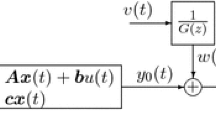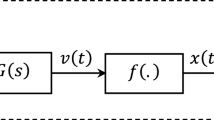Abstract
Multiple-input Wiener systems consist of two or more linear dynamic elements, whose outputs are transformed by a multiple-input static non-linearity. Korenberg (1985) demonstrated that the linear elements of these systems can be estimated using either a first order input-ouput cross-covariance or a slice of the second, or higher, order input-output cross-covariance function. Korenberg's work used a multiple input LNL structure, in which the output of the static nonlinearity was then filtered by a linear dynamic system. In this paper we show that by restricting our study to the slightly simpler Wiener structure, it is possible to improve the linear subsystem estimates obtained from the measured cross-covariance functions. Three algorithms, which taken together can identify any multiple-input Wiener system, have been developed. We present the theory underlying these algorithms and detail their implementation. Simulation results are then presented which demonstrate that the algorithms are robust in the presence of output noise, and provide good estimates of the system dynamics under a wide set of conditions.
Similar content being viewed by others
References
Bendat JS, Piersol AG (1986) Random data, analysis and measurement procedures, 2nd Edn. John Wiley, New York
Chen HW, Jacobson LD, Gaska JP (1990) Structural classification of multi-input nonlinear systems. Biol Cybern 63:341–357
Golub GH, Van Loan CF (1983) Matrix computations. Johns Hopkins University Press, Baltimore
Hunter IW (1985) Nonlinearities in isolated frog muscle fiber mechanical dynamics. Soc Neurosci Abstr 11:406
Hunter IW, Kearney RE (1982) Dynamics of human ankle stiffness: Variation with mean ankle toque. J Biomech 15:747–752
Hunter IW, Kearney RE (1983) Two sided linear filter identification. Med Biol Eng Comput 21:203–209
Hunter IW, Korenberg MJ (1986) The identification of nonlinear biological systems: Wiener and Hammerstein cascade models. Biol Cybern 55:135–144
Kearney RE, Hunter IW (1982) Dynamics of human ankle stiffness: Variation with displacement amplitude. J Biomech 15:753–756
Kearney RE, Hunter IW (1988) Nonlinear identification of stretch reflex dynamics. Ann Biomed Eng 16:79–94
Korenberg MJ (1973a) Identification of biological cascades of linear and static nonlinear elements. Proc Midwest Symp Circuit Theory 18:2:1–9
Korenberg MJ (1973b) Cross-correlation analysis of neural cascades. Proc Ann Rocky Mountain Bioeng Conf 1:237–245
Korenberg MJ (1973c) Obtaining differential equation, functional expansion or cascade representations for nonlinear biological systems. Proc New Engl Bioeng Conf 1:237–245
Korenberg MJ (1985) Identifying noisy cascades of linear and static nonlinear systems. Proc IFAC Identifie Syst Param Estim 1:421–426
Korenberg MJ (1991) Parallel cascade identification and kernel estimation for nonlinear systems. Ann Biomed Eng 19:429–455
Korenberg MJ, Hunter IW (1986) The identification of nonlinear biological systems: LNL cascade models. Biol Cybern 55: 125–134
Marmarelis PZ, Marmarelis VZ (1978) Analysis of physiological systems. Plenum Press, New York
Marmarelis PZ, Naka KI (1973) Nonlinear analysis and synthesis of receptive-field responses in the catfish retina, part III: Two-input white-noise analysis. J Neurophys 36:634–648
Marmarelis PZ, Naka KI (1974) Identification of multi-input biological systems. IEEE Trans Biomed Eng BME-21:88–101
Rugh WJ (1981) Nonlinear system theory, the Volterra/Wiener approach. Johns Hopkins University Press, Baltimore
Westwick DT, Perreault EJ, Kearney RE (1991) Estimation of Wiener kernels from non-white inputs: sampling rate considerations. Proc CMBEC 17:125–126.
Yasui S, Davis W, Naka KI (1979) Spatio-temporal receptive field measurement of retinal neurons by random pattern stimulation and cross covariance. IEEE Trans Biomed Eng BME-26:263–272
Author information
Authors and Affiliations
Rights and permissions
About this article
Cite this article
Westwick, D.T., Kearney, R.E. A new algorithm for the identification of multiple input Wiener systems. Biol. Cybern. 68, 75–85 (1992). https://doi.org/10.1007/BF00203139
Received:
Accepted:
Issue Date:
DOI: https://doi.org/10.1007/BF00203139




